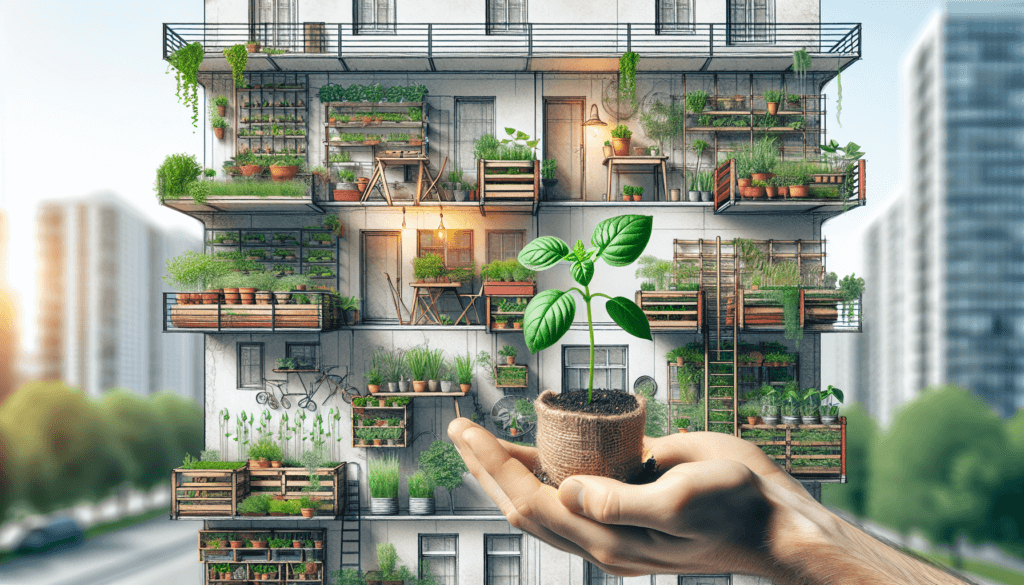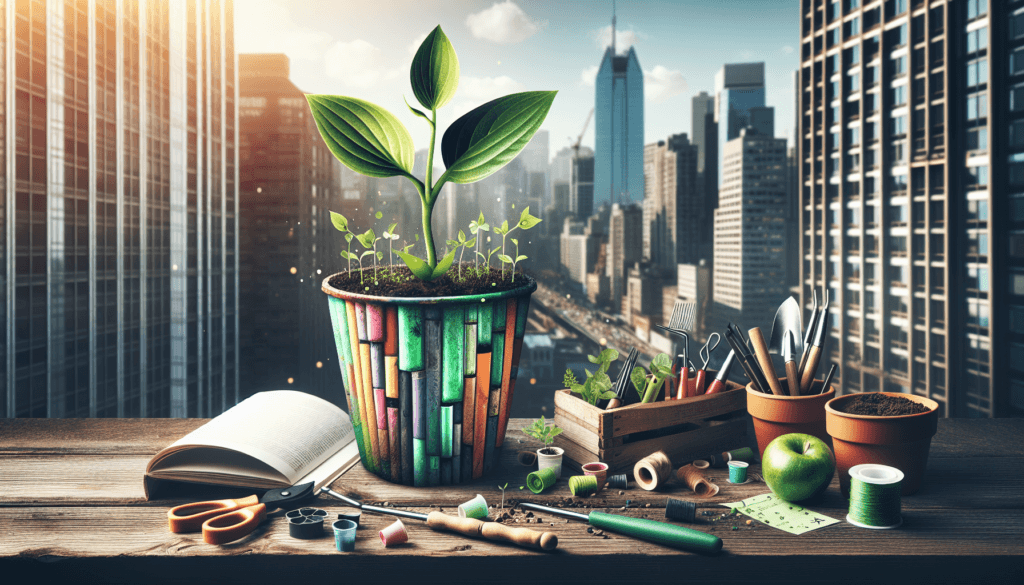Are you considering starting an urban garden but not sure where to begin? Look no further! This article provides a concise and informative guide to help beginners get started with urban gardening. Whether you have limited space or no prior gardening experience, these essential steps will set you on the path to cultivating your own garden oasis in the city. From choosing the right location and containers to selecting the ideal plants and ensuring proper care, this article covers all the basics you need to know to embark on your urban gardening journey. Get ready to transform your space into a green haven and enjoy the beauty and rewards of nurturing your very own urban garden.

Choosing the Right Location
Consider the available space
When starting an urban garden, it’s important to consider the available space you have. Whether you have a small balcony, rooftop, or a tiny yard, there are ways to maximize your gardening potential. Take a look at the space you have and visualize how you can make the most of it. Will you be using containers or raised beds? Can you hang plants from a trellis or vertical garden system? By assessing the available space, you can determine what types of plants and how many you’ll be able to grow.
Assess the sunlight exposure
Sunlight is crucial for the success of your urban garden. Before deciding on a location, assess the amount of sunlight it receives throughout the day. Most edible plants require at least 6 hours of direct sunlight, so it’s essential to find a spot that fits this requirement. Observe different areas of your space at different times of the day, noting which areas receive the most sunlight. By understanding your sunlight exposure, you can choose the best spot for your plants.
Evaluate the soil quality
The quality of your soil will play a significant role in the health and productivity of your plants. Start by evaluating the soil quality in your chosen location. Take a small sample and assess its texture, drainage, and composition. Does it feel sandy, clay-like, or loamy? Is it compacted or loose? Does it retain water well or drain too quickly? By understanding the soil quality, you can determine if your plants will need amendments or if you’ll need to use raised beds or containers with specific soil mixes.
Preparing the Soil
Remove weeds and grass
Before planting, it’s crucial to clear out any existing weeds or grass in your chosen location. Weeds compete with your plants for nutrients, water, and sunlight, so removing them will ensure your plants have the best chance of thriving. Use a garden fork or a shovel to loosen the soil and remove the weeds and grass. Take your time to ensure you remove the roots as well, as some weeds can quickly grow back if their roots remain.
Test the soil pH
Soil pH plays a vital role in the overall health of your plants. Different plants thrive in different pH levels, so it’s essential to test the soil before planting. You can easily purchase a pH testing kit at a local garden center or use a soil testing service. The ideal pH for most edible plants is around 6 to 7. If your soil’s pH is too low or too high, you may need to amend it with additives such as lime or sulfur to bring it to the appropriate level for the plants you wish to grow.
Amend the soil with organic matter
Adding organic matter to your soil is an excellent way to improve its structure, fertility, and ability to retain moisture. You can find various types of organic matter, such as compost, aged manure, leaf mold, or peat moss, readily available at garden centers. Mix in the organic matter with your soil, aiming for a ratio of approximately one part organic matter to two parts soil. This will help provide essential nutrients to your plants and promote healthy root development.

Selecting Suitable Plants
Research plant options
Before selecting plants for your urban garden, it’s essential to do some research. Consider the types of plants you’d like to grow, such as herbs, vegetables, or flowers. Look for plants that are well-suited for container gardening or compact spaces. Take note of their light requirements, water needs, and growth habits. By researching plant options, you can ensure you choose plants that are suitable for your specific conditions and gardening goals.
Consider your climate and weather conditions
Understanding your local climate and weather conditions is crucial when selecting plants for your urban garden. Different plants thrive in different climate zones, so it’s essential to choose plants that are well-adapted to your specific region. Consider the average temperature, frost dates, and rainfall patterns in your area. This information will help you determine which plants are more likely to be successful and help you plan for any necessary protective measures during extreme weather events.
Choose plants that thrive in containers
In urban gardening, containers are often the primary means of growing plants. When selecting plants, choose varieties that are well-suited for container gardening. Compact or dwarf varieties of vegetables and herbs are excellent choices, as they will take up less space and still provide an abundant harvest. Look for plants that have a bushy or trailing habit, as they will adapt well to limited space. Additionally, consider plants that have shallow root systems, as they will be more suitable for containers.
Deciding on Containers
Select appropriate container sizes
Choosing the right container size is crucial for the health and growth of your plants. Most plants require a minimum of 6 inches of soil depth, but some, like tomatoes or root vegetables, may need deeper containers. Consider the mature size of the plants you wish to grow and choose containers that will provide enough space for their root systems. Keep in mind that larger containers will generally require less frequent watering compared to smaller ones.
Consider the material of the containers
Containers are available in various materials, each with its own benefits and drawbacks. Some common options include ceramic, terracotta, plastic, and fabric. Ceramic and terracotta are aesthetically pleasing and provide good insulation, but they can be heavy and prone to cracking in freezing temperatures. Plastic containers are lightweight and durable, but they may not provide adequate insulation. Fabric containers are lightweight, breathable, and allow for excellent drainage, making them a popular choice for urban gardeners. Consider the advantages and disadvantages of each material and choose what best suits your needs.
Ensure containers have proper drainage
Good drainage is essential for the health of your plants. Containers should have drainage holes at the bottom to allow excess water to escape. Avoid using containers without drainage holes, as they can lead to root rot and other problems. Place saucers or trays beneath the containers to catch the excess water and prevent it from seeping onto floors or other surfaces. Additionally, consider elevating the containers slightly off the ground to allow for better air circulation and drainage.

Providing Adequate Watering
Determine watering needs of different plants
Different plants have varying watering needs, so it’s important to understand the requirements of the plants you’ve chosen. Some plants, like lettuce or herbs, prefer consistently moist soil, while others, like succulents, prefer periods of dryness between watering. Conduct research on the specific watering needs of each plant to ensure you provide adequate moisture without overwatering or underwatering.
Develop a watering schedule
Establishing a watering schedule will help ensure that your plants receive a consistent water supply. Consider factors such as your local climate, the type of soil, and the specific watering needs of your plants. Generally, it’s better to water deeply and infrequently rather than lightly and frequently. This encourages deeper root growth and helps your plants withstand periods of drought. Water early in the morning or late in the evening to minimize evaporation.
Install an efficient watering system
For urban gardeners, efficient watering systems can be a game-changer. Consider installing drip irrigation or soaker hoses to deliver water directly to the root zone of your plants. These systems minimize water waste and ensure that your plants receive adequate moisture. Additionally, using mulch around your plants can help retain moisture and reduce water evaporation from the soil surface.
Implementing Pest Control
Identify common garden pests
Even in an urban environment, garden pests can pose a threat to your plants. Learn to identify common garden pests such as aphids, snails, slugs, caterpillars, and spider mites. Regularly inspect your plants for signs of damage, including chewed leaves, stunted growth, or discolored foliage. By identifying pests early on, you can take appropriate action to control and minimize their impact on your garden.
Use natural pest control methods
When it comes to pest control, opt for natural and environmentally friendly methods. There are numerous organic pest control options available, such as companion planting, introducing beneficial insects, and using homemade sprays made from ingredients like neem oil or garlic. These methods can help reduce pests without using harmful chemicals that could negatively impact the environment or your health.
Monitor plants regularly
Regular monitoring is essential in maintaining a healthy garden. Take the time to inspect your plants for any signs of pest infestation, disease, or nutrient deficiencies. By catching issues early, you can implement appropriate measures to prevent further damage. Regular monitoring also allows you to track the growth and health of your plants and make any necessary adjustments to your gardening practices.

Feeding and Fertilizing Plants
Understand nutrient requirements of plants
Plants require essential nutrients for optimal growth and productivity. Understand the specific nutrient requirements of the plants you are growing. Different types of plants have varying needs, with some requiring more nitrogen, phosphorus, or potassium. Consider using organic fertilizers that provide a balanced mix of nutrients and micronutrients. This will help promote healthy plant growth and reduce the risk of nutrient deficiencies.
Choose suitable fertilizers
There are various types of fertilizers available, including granular, liquid, and slow-release options. Consider the needs of your plants, your gardening practices, and the convenience of application when choosing fertilizers. Organic fertilizers, such as compost or worm castings, are excellent choices for providing slow-release nutrients and improving soil health. Follow the recommended application rates and timings for each specific fertilizer to avoid overfertilization, which can harm your plants.
Apply fertilizers at appropriate times
Timing is crucial when it comes to fertilizing your plants. Apply fertilizers at the appropriate time to maximize their effectiveness. In general, fertilize plants before they begin actively growing, such as during the early spring season. Avoid fertilizing during periods of stress, such as extreme heat or drought. Additionally, consider using slow-release fertilizers that provide a steady supply of nutrients over time, reducing the need for frequent applications.
Maintaining Proper Plant Care
Prune and trim plants regularly
Regular pruning and trimming are essential for maintaining healthy and productive plants. Prune your plants to remove dead, damaged, or diseased branches, as well as to shape their growth. Trimming can help manage the size and shape of your plants, especially in limited urban spaces. Regularly removing spent flowers or fruit can also promote continuous blooming or fruiting throughout the season.
Remove dead or diseased plant material
Dead or diseased plant material can attract pests and diseases, harming the overall health of your garden. Regularly inspect your plants and promptly remove any dead or diseased leaves, stems, or flowers. Dispose of this plant material properly, either by composting or through municipal green waste services. By removing and disposing of dead or diseased material, you can prevent the spread of pests and diseases in your garden.
Monitor plant growth and health
Keeping an eye on the growth and health of your plants is crucial for successful urban gardening. Observe your plants regularly and take note of any changes in foliage color, growth patterns, or pest damage. Use this information to identify and address any potential issues before they become more significant problems. Regular monitoring will help you adjust your care practices and provide the necessary attention to keep your plants thriving.

Harvesting and Enjoying Produce
Know when to harvest different crops
Harvesting your homegrown produce at the right time is essential for peak flavor, texture, and nutrition. Research the specific harvesting times for each crop you’re growing. Look for visual cues, such as the color, size, or texture of the fruits or vegetables. Some crops, like tomatoes, should be harvested when they are fully ripe, while others, like leafy greens, can be harvested as young baby leaves or as mature plants. Harvest regularly to encourage continuous production throughout the season.
Store harvested produce properly
Proper storage is key to prolonging the freshness and shelf life of your harvested produce. Different crops have different storage requirements. Some fruits and vegetables, like tomatoes or peppers, can be stored at room temperature, while others, like leafy greens or root vegetables, require refrigeration. Be mindful of ethylene-producing produce, as it can accelerate the ripening or decay of other items. Consider storing produce in breathable bags or containers to help maintain optimal humidity levels and prevent spoilage.
Make delicious recipes with your homegrown food
One of the joys of urban gardening is enjoying the fruits of your labor in the kitchen. Get creative and make delicious recipes with the fresh produce from your garden. Experiment with different flavors and techniques, whether it’s making a vibrant pesto with homegrown herbs or preparing a fresh salad with harvested greens and veggies. The satisfaction of eating food you’ve grown yourself is unmatched, and it will surely inspire you to continue your urban gardening journey.
Continuing Education and Learning
Join local gardening communities
Connecting with like-minded individuals in your local area is an excellent way to expand your knowledge and exchange gardening tips. Join local gardening communities, such as clubs, forums, or social media groups. These communities often organize events, workshops, and plant swaps, allowing you to learn from experienced gardeners and share your own experiences. The support and camaraderie of fellow gardeners can be invaluable in your urban gardening journey.
Attend workshops and classes
Take advantage of various gardening workshops and classes offered in your community. These educational opportunities can cover a wide range of topics, from basic gardening techniques to specific plant care and propagation methods. Participating in workshops and classes can provide you with hands-on experience, expert guidance, and the chance to ask questions. Look for classes offered by local garden centers, botanical gardens, or agricultural extension programs in your area.
Read books and online resources
Books and online resources are excellent sources of inspiration and information for urban gardeners. Look for gardening books that focus on topics such as container gardening, edible gardening, or urban gardening specifically. Online platforms, blogs, and websites dedicated to gardening can provide helpful articles, tutorials, and practical advice. Regularly explore and bookmark trusted sources to expand your gardening knowledge and stay up to date with the latest trends and techniques.
By following these essential steps, you’ll be well on your way to creating a successful and rewarding urban garden. Remember, gardening is a journey of continuous learning and experimentation, so don’t be afraid to try new things and adapt your practices along the way. With a little bit of patience, passion, and care, you’ll soon be enjoying the bountiful harvest of your own urban oasis. Happy gardening!


